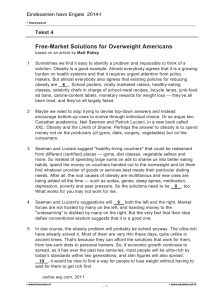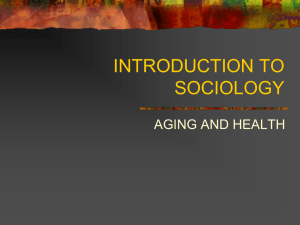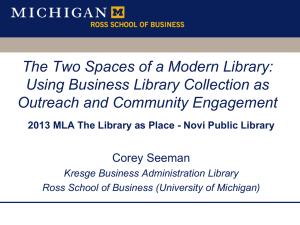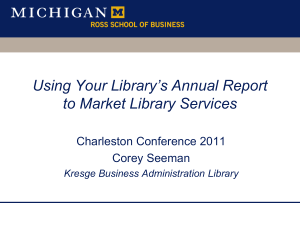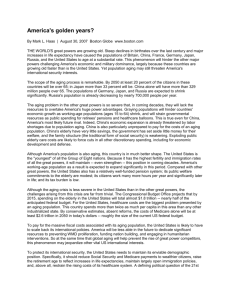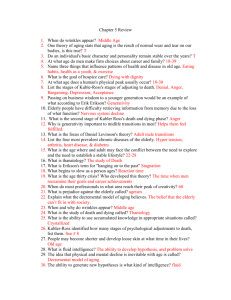Teresa Ellen Seeman - USC Davis School of Gerontology
advertisement
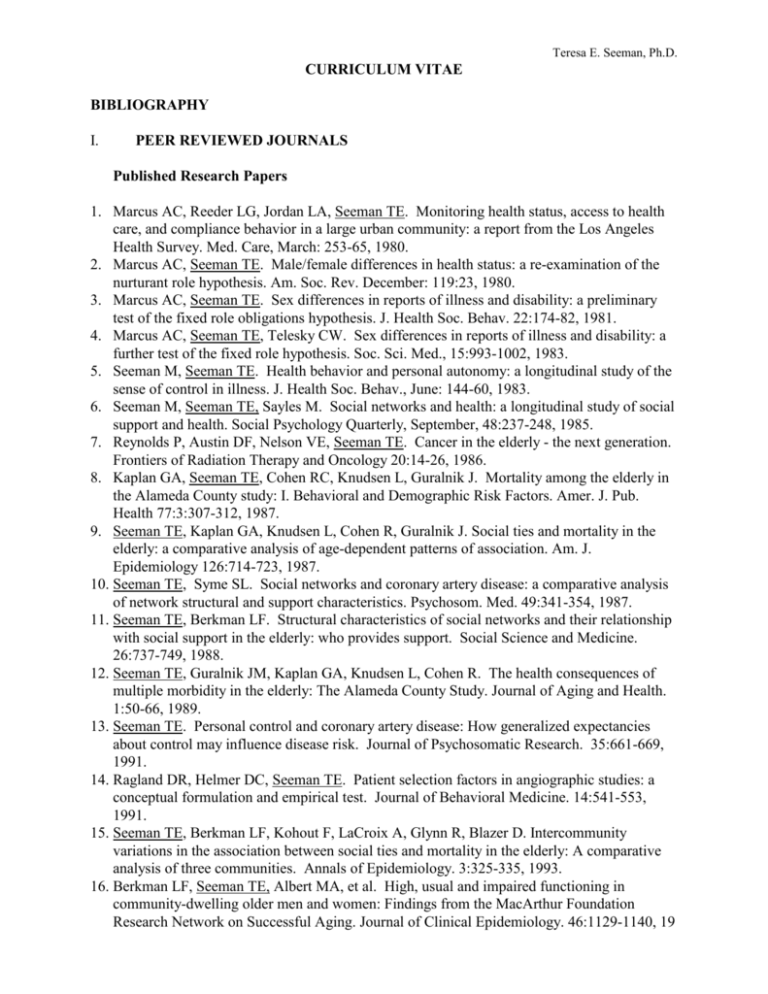
Teresa E. Seeman, Ph.D. CURRICULUM VITAE BIBLIOGRAPHY I. PEER REVIEWED JOURNALS Published Research Papers 1. Marcus AC, Reeder LG, Jordan LA, Seeman TE. Monitoring health status, access to health care, and compliance behavior in a large urban community: a report from the Los Angeles Health Survey. Med. Care, March: 253-65, 1980. 2. Marcus AC, Seeman TE. Male/female differences in health status: a re-examination of the nurturant role hypothesis. Am. Soc. Rev. December: 119:23, 1980. 3. Marcus AC, Seeman TE. Sex differences in reports of illness and disability: a preliminary test of the fixed role obligations hypothesis. J. Health Soc. Behav. 22:174-82, 1981. 4. Marcus AC, Seeman TE, Telesky CW. Sex differences in reports of illness and disability: a further test of the fixed role hypothesis. Soc. Sci. Med., 15:993-1002, 1983. 5. Seeman M, Seeman TE. Health behavior and personal autonomy: a longitudinal study of the sense of control in illness. J. Health Soc. Behav., June: 144-60, 1983. 6. Seeman M, Seeman TE, Sayles M. Social networks and health: a longitudinal study of social support and health. Social Psychology Quarterly, September, 48:237-248, 1985. 7. Reynolds P, Austin DF, Nelson VE, Seeman TE. Cancer in the elderly - the next generation. Frontiers of Radiation Therapy and Oncology 20:14-26, 1986. 8. Kaplan GA, Seeman TE, Cohen RC, Knudsen L, Guralnik J. Mortality among the elderly in the Alameda County study: I. Behavioral and Demographic Risk Factors. Amer. J. Pub. Health 77:3:307-312, 1987. 9. Seeman TE, Kaplan GA, Knudsen L, Cohen R, Guralnik J. Social ties and mortality in the elderly: a comparative analysis of age-dependent patterns of association. Am. J. Epidemiology 126:714-723, 1987. 10. Seeman TE, Syme SL. Social networks and coronary artery disease: a comparative analysis of network structural and support characteristics. Psychosom. Med. 49:341-354, 1987. 11. Seeman TE, Berkman LF. Structural characteristics of social networks and their relationship with social support in the elderly: who provides support. Social Science and Medicine. 26:737-749, 1988. 12. Seeman TE, Guralnik JM, Kaplan GA, Knudsen L, Cohen R. The health consequences of multiple morbidity in the elderly: The Alameda County Study. Journal of Aging and Health. 1:50-66, 1989. 13. Seeman TE. Personal control and coronary artery disease: How generalized expectancies about control may influence disease risk. Journal of Psychosomatic Research. 35:661-669, 1991. 14. Ragland DR, Helmer DC, Seeman TE. Patient selection factors in angiographic studies: a conceptual formulation and empirical test. Journal of Behavioral Medicine. 14:541-553, 1991. 15. Seeman TE, Berkman LF, Kohout F, LaCroix A, Glynn R, Blazer D. Intercommunity variations in the association between social ties and mortality in the elderly: A comparative analysis of three communities. Annals of Epidemiology. 3:325-335, 1993. 16. Berkman LF, Seeman TE, Albert MA, et al. High, usual and impaired functioning in community-dwelling older men and women: Findings from the MacArthur Foundation Research Network on Successful Aging. Journal of Clinical Epidemiology. 46:1129-1140, 19 17. Seeman TE, Rodin J, Albert MA. Self-efficacy and functional ability: how beliefs relate to cognitive and physical performance. Journal of Aging and Health. 5:455-474, 1993. 18. Seeman TE, Mendes de Leon C, Berkman LF, Ostfeld A. Risk factors for coronary heart disease among older men and women: A prospective study of community-dwelling elderly. American Journal of Epidemiology. 138:1037-1049, 1993. 19. Berkman LF, Vaccarino V, Seeman T. Gender differences in cardiovascular morbidity and mortality: The contribution of social networks and support. Annals of Behavioral Medicine. 15:112-118, 1993 20. Malmrose LC, Gray SL, Pieper CF, Blazer DG, Rowe JW, Seeman TE, Albert MS. Measured versus estimated creatinine clearance in a high-functioning elderly sample: MacArthur Foundation Study of Successful Aging. J Am Geriatrics Society. 41:715-721, 1993. 21. Simonsick EM, Lafferty ME, Phillips CL, Mendes de Leon CF, Kasl SV, Seeman TE, Fillenbaum G, Hebert P, Lemke J. Risk due to inactivity in physically capable older adults. American Journal of Public Health. 83:1443-1450, 1993. 22. Seeman TE, Charpentier PA, Berkman LF, Tinetti ME Guralnik JM, Albert M, Blazer D, Rowe JW. Predicting changes in physical performance in a high functioning elderly cohort: MacArthur studies of successful aging. Journal of Gerontology, 49:M97-M108, 1994. 23. Amin F, Seeman TE, Mohs RC, Davidson M, Knott P, Berkman LF, Albert M, Blazer D. Plasma homovanillic acid and performance on motor and cognitive tasks in communitydwelling elderly: MacArthur Studies of Successful Aging. Neuropsychopharmacology, 10:29-35, 1994. 24. Schoenfeld DE, Malmrose LC, Blazer DG, Seeman TE. The relationship between self-rated health and mortality in the elderly: Its usefulness in healthy individuals. J of Gerontology, 49:M109-M115, 1994. 25. Seeman TE, Berkman LF, Blazer D, Rowe J. Social ties and support and function: MacArthur Studies of Successful Aging. Annals of Behavioral Medicine, 16:95-106, 1994. 26. Burg MM, Seeman TE. Families and Health: the negative side of social ties. Annals of Behavioral Medicine, 16:109-115, 1994. 27. Krumholz HM, Seeman TE, Merrill S et al. Lack of association between cholesterol and coronary heart disease mortality and morbidity and all-cause mortality in persons older than 70 years. JAMA 272(17):1335-1340, 1994. 28. Bruce ML, Seeman TE, Merrill SS, Blazer DG. Depression and onset of ADL disability: MacArthur Studies of Successful Aging AJPH, 84:1796-1799, 1994. 29. Guralnik JM, Seeman TE, Berkman LF, Tinetti ME, Nevitt MC. Validation and use of performance measures of functioning in a non-disabled older population: MacArthur Studies of Successful Aging. AGING: Clinical and Experimental Research 6(6):410-419, 1994. 30. Seeman TE, Berkman LF, Gulanski B, Robbins R, Greenspan S, Charpentier P, Rowe J. Selfesteem and neuroendocrine response to challenge: MacArthur Successful Aging Studies. Psychosomatic Research 39:69-84, 1995. 31. Seeman TE, Berkman LF, Charpentier P, Blazer D, Albert M, Tinetti M. Behavioral and Psychosocial Predictors of Physical Performance: MacArthur Studies of Successful Aging. J Gerontol: Med Sci 50A:M177-M183, 1995. 32. Glass TA, Seeman TE, Herzog R, Kahn R, Berkman LF. Change in productive activity in late adulthood: MacArthur Studies of Successful Aging J Gerontol 50B:S65-S76, 1995. BIBLIOGRAPHY (con’t) 33. Corti M, Guralnik JM, Salive ME, Harris T, Field TS, Wallace RB, Berkman LF, Seeman TE, Glynn RJ, Hennekens CH, Havlik RJ. Lipoproteins and coronary heart disease mortality in older adults: Established Populations for Epidemiologic Studies of the Elderly. JAMA 274:539-544, 1995. 34. Seeman TE, Singer B, Charpentier. Gender Differences in HPA Response to Challenge: MacArthur Studies of Successful Aging. Psychoneuroendocrinology 20:711-725, 1995. 35. Albert MS, Jones K, Savage CR, Berkman L, Seeman T, Blazer D, Rowe JW. Predictors of Cognitive Change in Older Persons: MacArthur Studies of Successful Aging. Psychology and Aging 10:578-589, 1995. 36. Mendes de Leon CF, Seeman TE, Baker DI, Doucette JT, Tinetti ME. Self-efficacy, physical performance and functional decline in a cohort study of community-living elders. J Gerontol: Soc Sci 51B:S183-S190, 1996. 37. Seeman TE, Bruce ML, McAvay G. Social Network Characteristics and Onset of ADL Disability: MacArthur Studies of Successful Aging. J Gerontol:Social Sciences 51B:S191S200, 1996. 38. McAvay GJ, Seeman TE, Rodin J. A Longitudinal Study of Change in Domain-Specific Self-efficacy Among Older Adults. J Gerontol:Psychological Sciences 51B:P243-P253, 1996. 39. Seeman TE, McEwen BS. Social Environment Characteristics and Neuroendocrine Function: the Impact of Social Ties and Support on Neuroendocrine Regulation. Psychosomatic Medicine 58:459-471, 1996. 40. Seeman TE, McAvay G, Merrill S, Albert M, Rodin J. Self-Efficacy Beliefs and Changes in Cognitive Performance: MacArthur Studies of Successful Aging. Psychology & Aging 11:538-551, 1996. 41. Vaccarino V, Krumholz HM, Mendes de Leon CF, Holford TR, Seeman TE, Horwitz RI, Berkman LF. Sex Differences in Survival after Myocardial Infarction in the Elderly: a Community-based Approach. Journal of the Am Ger. Soc 44:1174-1182, 1996. 42. Krumholz HM, Vaccarino V, Mendes de Leon CF, Seeman TE, Berkman LF. Cholesterol and coronary heart disease mortality in elderly patients [letter; comment], JAMA 275:110-1, 1996. 43. DiPietro L, Seeman TE, Merrill SS, Berkman LF. Physical Activity and measures of cognitive function in a cohort of health older adults: The MacArthur Study of Successful Aging. J of Aging and Physical Activity 4:362-376, 1996. 44. Seeman TE. Social Ties and Health. Annals of Epidemiology 6:442-451, 1996. 45. Seeman TE, McEwen BS, Singer B, Albert M, Rowe JW. "Increase in Urinary Cortisol Excretion and Declines in Memory: MacArthur Studies of Successful Aging" J Clin Endo & Metabol 82:2458-2465, 1997. 46. Seeman TE, Singer B, Horwitz R, McEwen BS. "The Price of Adaptation --Allostatic Load & Its Health Consequences: MacArthur Studies of Successful Aging" Archives of Internal Medicine 157:2259-2268, 1997. 47. Merrill S, Seeman T, Kasl S, Berkman L. Gender Differences in Comparisons of Selfreported Disablity and Performance Measures. J Gerontol: Med Sci.52A:M14-M18, 1997. 48. Dealberto MJ, Seeman T, McAvay G, Berkman L. Factors related to current and subsequent psychotropic drug use in an elderly cohort. J Clin Epidemiol 50:357-364, 1997. 49. Dealberto MJ, McAvay GJ, Seeman TE, Berkman LF. Psychotropic drug use an cognitive decline among older men and women. International J of Geriatric Psychiatry 12:567-574, 1997. BIBLIOGRAPHY (con’t) 50. Vaccarino V, Berkman LF, Mendes de Leon C, Seeman TE, Horwitz R, Krumholz, H. Functional disability before myocardial infarction in the elderly is a determinant of infarction severity. Arch Int Med 157:2196-2204, 1997. 51. Glass TA, Mendes de Leon CF, Seeman TE, Berkman LF. Beyond single indicators of social networks: a LISREL analysis of social ties among the elderly. Soc Sci & Med., 44:1503-17, 1997. 52. Whitfield KE, Seeman TE, Miles TP, Albert M, Blazer D, Rowe JW. Health indices as predictors of cognition among older African-Americans: MacArthur Studies of Successful Aging. Ethnicity & Disease 7:127-36, 1997 53. Seeman T, Adler N. Older Americans: Who Will They Be? -- Socio-demographic Changes in the Population of Older Americans and Their Potential Health Consequences. National Forum, 78:22-25, 1998 54. Kubzansky LD, Berkman LF, Glass TA, Seeman TE. Is educational attainment associated with Shared Determinants of Health in the Elderly?: Findings from the MacArthur Studies of Successful Aging. Psychosomatic Med. 60:578-85, 1998. 55. DiPietro L, Seeman TE, Stachenfeld NS, Katz LD, Nadel ER. Moderate-intensity aerobic training improves glucose tolerance in aging independent of abdominal adiposity. JAGS 46:875-9, 1998. 56. Zelinski E, Crimmins E, Reynolds S, Seeman T. Do Medical Conditions Affect Cognition in Older Adults?: Results from the AHEAD Study. Health Psychology, 1998,17:504-525 57. Krumholz HM, Butler J, Miller J, Vaccarino V, Williams C, Mendes de Leon CF, Seeman TE, Kasl SV, Berkman LF. The prognostic importance of emotional support for elderly patients hospitalized with heart failure. Circulation, 1998, 97:958-964. 58. Mendes de Leon CF, Krumholz HM, Seeman TS, Vaccarino V, Williams CS, Kasl SV, Berkman LF. Depression and Risk of Coronary Heart Disease in Elderly Men and Women.: the New Haven EPESE 1982-1991, Established Populations for the Epidemiologic Studies of the Elderly Arch Int Med., 1998; 158:2341-8 59. Reuben D, Ix J, Greendale G, Seeman T. The Predictive Value of Combined Hypoalbuminemia and Hypocholesterolemia in High Functioning Community-Dwelling Older Persons. JAGS, 1999, 47:402-406 60. Seeman TE, Unger J, McAvay G, Mendes deLeon. The Role of Self-efficacy beliefs in Perceptions of Functional Disability: MacArthur Studies of Successful Aging. J Gerontol:Psychol Sci, 54A:P214-P222, 1999. 61. Greendale G, Unger JB, Rowe JW, Seeman T. The Relationship Between Cortisol and Fractures in Health Elderly: The MacArthur Studies of Successful Aging” JAGS, 47:799803, 1999. 62. Mendes de Leon CF, Glass TA, Beckett LA, Seeman TE, Evans DA, Berkman LF. Social networks and disability transitions across eight intervals of yearly data in the New Haven EPESE. J Gerontol: Soc Sciences, 1999; 54B:S162-S172. 63. Unger J, McAvay G, Bruce M, Berkman LF, Seeman TE. Variation in the Impact of social network characteristics on physical functioning in elderly persons: MacArthur Studies of Successful Aging. J Gerontol Soc Sci., 1999; 54B:S245-252. 64. Bretsky PM, Buckwalter JG, Seeman TE, Miller CA, Poirier J, Schellenberg GD, Finch CE, Henderson VW. Evidence for an interaction between Apolipoprotein E genotype, gender and Alzeheimer Disease. Alzheimer Disease and Associated Disorders, 1999; 4:216-221. BIBLIOGRAPHY (con’t) 65. Whitfield KE, Fillenbaum C, Pieper C, Albert MS, Berkman LF, Blazer DG, Rowe JW, Seeman TE. The effect of race and health related factors on naming and memory: The MacArthur Studies of Successful Aging. Journal of Aging and Health, 2000; 12:69-89. 66. Tabbarah M, Silverstein M, Seeman T. A Health and Demographic Profile of NonInstitutionalized Older Americans Residing in Environments with Home Modifications. Journal of Aging and Health, 2000; 12:204-228. 67. Seeman TE. Health Promoting Effects of Friends and Family: The Impact of the Social Environment on Health Outcomes in Older Adults. Am J of Health Promotion, 14:362-370, 2000. 68. Carlson MC, Seeman T, Fried LP. Importance of generativity for health aging in older women. Aging Clinc. Exp. Res. 12:132-40, 2000. 69. Berkman LF, Glass T, Brissette I. Seeman TE. From social integration to health: Durkheim in the new millennium. Soc Sci and Medicine, 51:843-857, 2000. 70. Epel, ES, McEwen B, Seeman T, Matthews K, Castellazzo G, Brownell KD, Bell J, Ickovics JR. Stress and body shape: stress-induced cortisol secretion is consistently greater among women with central. Psychosomatic Med, 62:623-632, 2000. 71. Greendale GA, Kritz-Silverman D, Seeman T, Barrett-Connor E. Higher basal morning cortisol predicts verbal memory loss in women: Rancho Bernardo Study. J Am Geriatr Soc 2000;48:1655-58 72. Greendale G, D’Amicis T, Bretsky P, Rowe JW, Reuben DB, Seeman T. A prospective study of the effect of fracture on measured physical performance: Results from the MacArthur Studies of Successful Aging. J Am Geriatr Soc. 2000;48:546-49. 73. Reuben D, Talvi S, Seeman TE. High urinary catecholamine excretion predicts mortality and functional decline in high functioning community-dwelling older persons: MacArthur Studies of Successful Aging. J Gerontol: Med Sci 2000, 55A:M618-M624. 74. Taaffe DR, Harris TB, Ferrucci L, Rowe JW, Seeman TE. Cross-sectional and prospective relationships of interleukin-6 and c-reactive protein with physical performance in the elderly: MacArthur Studies of Successful Aging. J Gerontol: Biol. & Med Sci; 2000, 55:M709-15 75. Pham LB, Taylor SE, Seeman T. The effects of environmental predictability and mastery on self-regulation and physiological reactivity. Pers & Soc Psycol Bull., 27:611-620, 2001. 76. Fried LP, Tangen CM, Walston J, Newman AB, Hirsch C, Gottdiener J, Seeman T, Tracy R, Kop WJ, Burke G, McBurnie MA. Frailty in older adults: evidence for a phenotype. J Gerontol: Biol Sci, 56:M134-5, 2001. 77. Seeman TE, Singer B, Rowe J, McEwen B. Exploring a new concept of cumulative biological risk -- Allostatic load & its health consequences: MacArthur Studies of Successful Aging. Proc Nat Acad Sci USA 98(8): 4770-4775, 2001. 78. Seeman TE, Singer B, Wilkinson C, McEwen B. Gender Differences in Age-Related Changes in HPA axis Reactivity. Psychoneuroendocrinology, 26:225-240, 2001. 79. Seeman TE, Lusignolo T, Berkman L, Albert M. Social Environment Characteristics and Patterns of Cognitive Aging: MacArthur Studies of Successful Aging Health Psychology 20:243-255, 2001. 80. Seeman TE, , Singer B, Ryff C Levy-Storms L. Psychosocial factors and the development of allostatic load (in press, Psychosomatic Med). 81. Wight RG, Aneshensel CS, Seeman TE. Educational attainment, continued learning experience and cognitive function among older men (in press, J Health and Aging) BIBLIOGRAPHY (con’t) 82. Repetti RL, Taylor SE, Seeman TE. Risky families: Family social environments and the mental and physical health of offspring. (in press, Psych Bull). ) 83. Hu P, Seeman TE, Harris T, Reuben D. Is serum uric acid level associated with all-cause mortatlity in high-functioning elderly persons: MacArthur Studies of Successful Aging (in press, JAGS) 84. Seeman TE, Chen J. The Role of Psychosocial and Behavioral Factors in Adaptation to Chronic Conditions: MacArthur Studies of Successful Aging (in press, J Gerontol:Soc Sci). 85. Reuben DB, Cheh AL, Harris TB, Ferrucci L, Rowe JW, Tracy RP, Seeman TE. Peripheral blood markers of inflammation predict mortality and functional decline among high functioning community-dwelling older persons. JAGS (in press). 86. Moore AA, Seeman T, Morgenstern H, Beck JC, Reuben DB. Are there differences among older persons who screen positively on the CAGE Questionnaire and the Short Michigan Alcoholism Screening Test-Geriatric Version (SMAST-G)? (in press, JAGS). 87. Tabbarah M, Crimmins E, Seeman TE. Relationship between Cognitive and Physical Performance: MacArthur Studies of Successful Aging (in press, J Gerontol: Med Sci). 88. Greendale GA, FitzGerald G, Huang M-H, Sternfeld B, Gold E, Seeman T, Sherman S, Sowers MF. Dietary soy isoflavone and bone mineral density: Results from the Study of Women's Health Across the Nation (SWAN). (in press: Am J Epidemiol) 89. Chodosh J, Reuben D, Albert M, Seeman TE. Predicting cognitive impairment in high functioning community-dwelling older persons: MacArthur Studies of Successful Aging (in press, JAGS). 90. Karlamangla A, Singer BS, McEwen B, Seeman TE. Further Analysis of Allostatic Load: Canonical correlation. (in press, J Clin Epid.). 91. Huang MH, Schocken M, Block G, Sowers MF, Gold E, Sternfeld B, Seeman T, Greendale GA. Variation in nutrient intakes by ethnicity: Results from the Study of Women’s Health Across the Nation (SWAN). (in press, Menopause). BIBLIOGRAPHY (con’t) II. CHAPTERS Published 1. Syme SL, Seeman TE. Sociocultural risk factors in coronary heart disease. In: Herd, JA (Ed.) Behavior and Arteriosclerosis. Plenum Publishing Co., pp. 55-71, 1983. 2. Berkman LF, Oxman TE, Seeman TE. Social networks and social support among the elderly: Assessment issues. The Epidemiology of Aging. R Wallace (Ed.), Oxford University Press, pp. 196-212, 1991. 3. Finch C, Seeman T. Stress Theories of Aging. Stress Theories of Aging. In Bengtson VL, Ruth JE and Schaie KW (eds), Handbook of Theories of Aging. New York: Springer Publishing, 1998, pp. 81-97. 4. Unger J, Seeman TE. Successful Aging. In Women and Health, Goldman MB and Hatch MC (eds). San Diego: Academic Press, 1999, pp.1238-1250. 5. Brissette I, Cohen S, Seeman T. Measuring Social Integration and Social Networks. In Cohen S, Underwood L and Gottlieb B (eds), Social Support Measurement and Intervention. New York: Oxford Press, pp. 53-85, 2000. 6. Seeman TE. How do Others Get Under Our Skin: Social Relationships and Health. In. Ryff CD & Singer B (eds), Emotion, Social Relationships and Health. New York: Oxford Press (forthcoming). 7. Seeman TE. Integrating Psychosocial Factors with Biology: A Case Study of Interdisciplinary Research. (submitted to Social Science Research Council as part of an edited volume on interdiscipinary research.) 8. McEwen BS, Seeman TE. Protective and damaging effects of mediators of stress. In Socioeconomic Status and Health in Industrial Nations: Social, Psycholoigcal and Biological Pathways, Adler NE, Marmot M, McEwen BS (eds), NY: NY Academic of Sciences, 1999;896:30-47. 9. Taylor S, Seeman TE. Psychosocial resources and the SES/Health Relationship. In Socioeconomic Status and Health in Industrial Nations: Social, Psycholoigcal and Biological Pathways, Adler NE, Marmot M, McEwen BS (eds), NY: NY Academic of Sciences, 1999, 896:210-225. 10. Crimmins EM, Seeman TE. Integrating biology into demographic research on health and aging (with a focus on the MacArthur Study of Successful Aging). In Finch CE and Vaupel JW (eds), Cells and Surveys: Should Biological Measures be Included in Social Science Research. National Academy Press. 2001. 11. Seeman TE, Crimmins E. Social Environment Effects on Health and Aging: Integrating Epidemiological and Demographic Approaches and Perspectives. Population Health and Aging: Strengthening the Dialogue between Epidemiology and Demography. M. Weinstein, AI Hermalin and MA Stoto (eds). Annals of the New York Academy of Sciences. Vol 954, pp.88-117, 2001. 12. McEwen BS, Seeman TE. Stress and Affect: applicability of the concepts of allostasis and allostatic load. In Handbook of Affective Science, Davidson R & ??? (eds). In press. BIBLIOGRAPHY (con’t) LETTERS TO THE EDITOR III. REVIEWS Published 1. Berkman LF, Seeman TE. The influence of social relationships on aging and the development of cardiovascular disease - a review. Postgraduate Medical Journal 62:805-07, 1986. 2. Seeman TE. Successful Aging: Reconceptualizing the aging process from a more positive perspective. Facts and Research in Gerontology, 8:3-15, 1994. 3. Seeman TE, Robbins RJ. Aging and hypothalamic-pituitary-adrenal response to challenge in man. Endocrine Reviews, 15:233-260, 1994. 4. Taylor SE, Repetti RL, Seeman TE. "What is an Unhealthy Environment and How Does It Get Under the Skin?" Annual Review of Psychology, 48:411-47, 1997. Published 1. Seeman TE, Berkman LF, Kohout F, LaCroix A, Glynn R. Social ties and mortality in the elderly: a comparison of three communities. AJE. 1991;134:762. 2. Mendes de Leon C, Seeman TE, Berkman LF, Ostfeld A. Risk Factors of CHD in the Elderly: A Community-based Prospective Study. AJE. 1991;134:761. 3. Seeman TE, Gulanski B, Berkman L, Robbins R, Rowe J. Self-esteem as a Predictor of Neuroendocrine Response to Challenge at Older Ages. 1992. 4. Gold DT, Malmrose LC, Pieper CF, Seeman TE, Blazer DG. "Successful Aging and Grade of Membership (GOM): A Typology" The Gerontologist 1993;33:252. 5. Krumholz HM, Seeman TE, Merrill S et al. Elevated cholesterol does not predict increased total mortality, cardiac mortality or myocardial infarction in the elderly. Circulation 1993; 88:612. 6. Seeman TE, Charpentier PA, Robbins R. Neuroendocrine Reactivity to Challenge: the Role of Personal Control Beliefs, Situational Experience and Gender. Annals of Behavioral Medicine 1994;16:S132. 7. Seeman TE, Singer B. Gender Differences in Patterns of HPA Axis Response to Challenge in Older Age. (ISPNE meetings). 1994. 8. Seeman TE, Singer B., Gulanski B, Robbins R. Gender and HPA Axis Response to Challenge in Older Adults: Pharmacologic vs. Psychological Challenge. (World Congress on Stress). 1994. 9. Seeman TE. Predictors of Successful Aging: MacArthur Studies (Symposium, GSA 1994) 10. Seeman TE, McAvay G, Rodin J. Social Network Characteristics and Changes in SelfEfficacy Beliefs. Presentation at Society for Behavioral Medicine meetings, San Diego, March 21-25, 1995. 11. Seeman, TE and Berkman LF. Social Network and Support Characteristics in relation to Incidence and Mortality from CHD. Symposium at Society for Behavioral Medicine meetings, San Diego, March 21-25, 1995 12. Seeman T Resiliency in Aging: HPA Axis response to Challenge in Older Adults. Symposium American Psychological Asso. New York, August, 1995. 13. Seeman TE, McAvay G, Merrill S, Albert M, Rodin J. Self-Efficacy Beliefs and Changes in Cognitive Performance: MacArthur Studies of Successful Aging. Gerontological Society of America, Los Angeles, November, 1995 14. Seeman TE, Unger J, McAvay G. Functional Disability: the Consequences of Low Selfefficacy Beliefs. Annals of Behavioral Medicine, 1997;19:S137. 15. Zelinski E, Crimmins E, Reynolds S, Seeman T. Do Medical Conditions Affect Cognition in Older Adults?: Results from the AHEAD Study. Gerontology Society of America 1997. 16. Crimmins E, Lu R, Seeman TE. Measurement Issues in Survey Assessments of Cognitive Functioning. GSA 1998. 17. Lusignolo T, Seeman TE. Social Relationships and Cognitive Function: the protective effects of emotional support. AGS 1999. 18. Chodosh J, Seeman TE. Delayed recall as an early predictor of cognitive impairment. GSA Nov.1999. BIBLIOGRAPHY (con’t) 19. Tabbarah M, Crimmins E, Seeman T. The effects of psycho-social factors on the relationship between self-reported and performance-based measures of functioning. GSA, Nov. 1999. 20. Pham LB, Taylor SE, Seeman TE. Effects of environmental predictability and personal mastery on self-regulatory and physiological processes. Society for Personality and Social Psychology, Nashville, 2000 21. Lin IF, Goldman N, Weinstein M, Seeman T, Lin YH, Gorrindo T. Transitions in support among the elderly in Taiwan. Population Asso. Amer, March 2000. 22. Weaver J, Albert MA, Harris T, Rowe J, Seeman TE. Interleukin-6 as a predictor of cognitive functioning: MacArthur Studies of Successful Aging. AGS, Nashville, May 2000 23. Kado D, Bucur A, Seeman TE. Homocysteine as a predictor of physical functioning: MacArthur Studies of Successful Aging. AGS, Nashville, May 2000. 24. Tabbarah M, Crimmins EM, Seeman TE. The Effect of change in cognitive performance on change in physical performance based measures of physical functioning. GSA, Washington, DC, Nov. 2000. 25. Kado D, Bucur A, Selhub J, Seeman T. Effects of homocysteine on risk of cognitive decline. AGS, May 2001. 26. Hu P, Reuben D Seeman T. Is Serum Uric Acid Level Associated With All-Cause Mortality In High-Functioning Elderly Persons: Macarthur Studies Of Successful Aging. AGS, May 2001. 27. Tabbarah M, Crimmins E, Seeman T. The relationship between cognitive and physical performance: MacArthur Studies of Successful Aging. 6th Annual UCLA Research Conference on Aging, Proceedings & Abstracts, June 2001, p.40. 28. Karlamangla A, Singer BS, McEwen BS, Seeman TE. Further Analysis of Allostatic Load: Canonical correlation. Abstract accepted for Gerontological Society of American, November 2001. 29. Karlamangla A, Reuben D, Singer BS, Seeman TE. Increases in serum cholesterol over time may be beneficial in high-functioning elderly men and women: MacArthur Studies of Successful Aging. 30. Hu P, Reuben D, Crimmins E, Seeman T. The effects of serum beta-carotene and c-reactive protein levels on all-cause mortality in high-functioning older persons: MacArthur Studies of Successful Aging.
